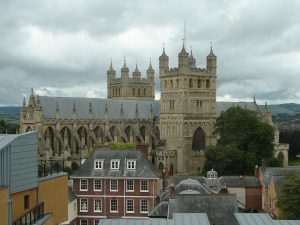The seat of the diocese in Devon is the city of Exeter, and it is the setting for Plague of a Green Man, the second novel in my Lady Apollonia West Country Mysteries. Exeter began as Isca in the province of Dumnoniorum in Roman Britain and was home to the Second Augustan Legion from 55 to 75 AD. The present medieval wall defines the city centre and largely survives in the same place as the 1st century Roman wall did. Occasionally, Roman bricks may still be seen, embedded in the medieval wall. Part of the Roman Baths were excavated in front of Exeter Cathedral in the 1970’s but then were covered over for long term protection.
The medieval city is dominated by its 14th century decorated Gothic cathedral which was nearly completed at the time of my novel in 1380. Only the top register of carvings on the west front was added after 1380. Other buildings from the period remain, some still in use today, some in ruins. The Guild Hall has served as the civic centre of the city since the second half of the twelfth century. Some parts of Saint Nicholas Priory remain but not the church. One building exists from Saint Catherine’s Priory in the Polsloe area. Stepcote Hill declares its medieval origins. Part of Exeter’s medieval bridge over the River Exe survives beyond the West Gate but no longer crosses the river. Many of these buildings are referred to in my story. Tragically, other ancient buildings were destroyed by Nazi bombing during the Second World War.
Exeter Cathedral, viewed from the northeast:
Tags: Chaucer's England, historical fiction, medieval mysteries